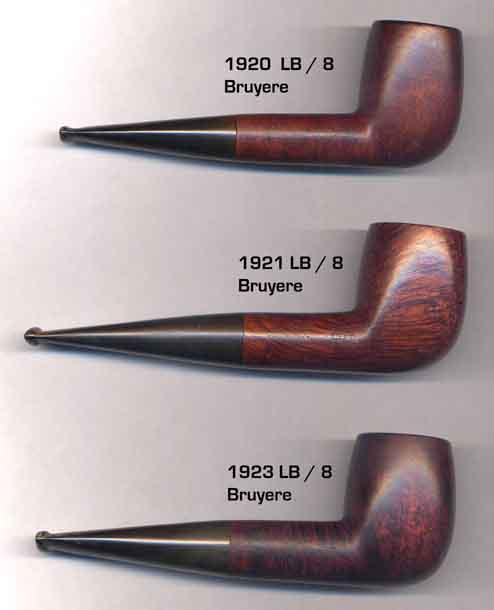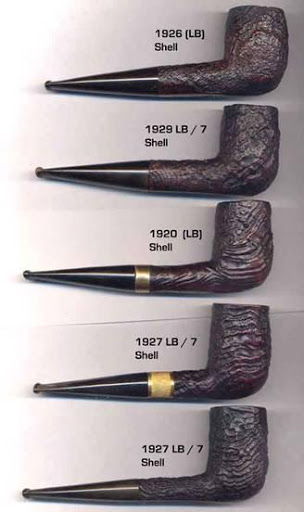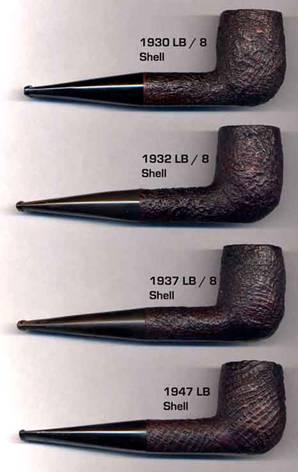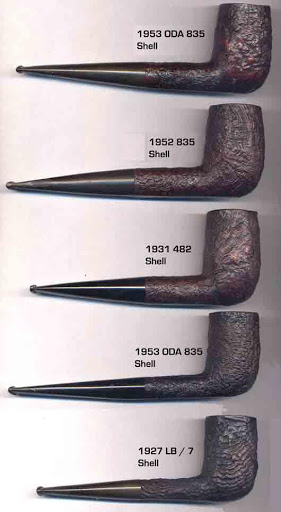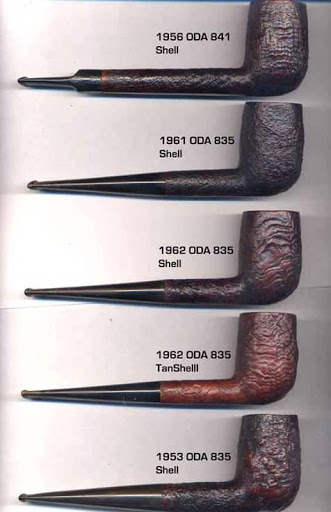Dunhill Large Billiard Variations
DUNHILL LARGE BILLIARD VARIATIONS © John C Loring: used by permission
Contributed by Jean-Christophe Bienfait
For heart the 20th century, from the end of World War I through 1975 (the year Dunhill changed its shape identifier system to that in place today) Dunhill’s two most important large billiards were the LB and the ODA/835. Over the years both these shapes remained fairly consistent, but at differing times each shape experienced a relatively brief but similar and noteworthy variant.
Dunhill introduced the LB shortly following the end of World War I and the shape soon became one of, if not the most popular. The principal attributes of the shape, a thick shank and ‘applish billiard’ bowl are found at inception and for the great most part consistently thereafter. (See picture #1) In my view the only significant LB variant is a seemingly parallel line of thin, ultimately “pencil” shank, straight sided, taller bowl pipes during the 1920s, apparently exclusively Shells, that were stamped LB just like their thick shank, applish bowled brethren.
As shown in the accompanying scan of five Shell LBs from the 1920’s (see picture #2), while standard shape Shell LBs were produced (the top most 1926 piece) to varying degrees most Shells departed from the standard, as demonstrated in the extreme by the 1927 LB pictured at the bottom, to the point of being a completely different shape in all but name. Indeed the same is only slightly less true for the two gold banded pipes pictured next above, with second from the top pictured pipe seemingly serving as a transition piece as it departs from the standard LB shape only as regards its straight sided bowl. Yet three of these variants are stamped LB (the fourth is not stamped with a shape identifier). There is however, one stamping distinction, the three stamped variants are stamped LB / 7, while the four Bruyere LBs I have from the 1920s (one is not pictured) are stamped LB / 8, the latter number in each case being the inner tube code. To add to the mystery starting about 1930 this “LB / 7” variant, which dominated 1920’s Shell LB production, completely disappears, (see picture #3). [However, the post World War II LBS can claim similar elements. The post war ODA 832 and 841 are also noteworthy given the similar contrasts. The 832, the earliest known post war “ODA’ shape (two Shells are known from 1949), was a classic LB with a slightly thicker bowl and shank and most noteworthy an extended ‘Canadian’ length shank and short saddle bit. A few years later the ODA 841 was introduced which was essentially an 832 on a diet, a thinner taller bowl, an even longer and dramatically thinner shank, and a short saddle bit.] Thenceforth all Shell LBs are carved to the standard shape and like Bruyeres, stamped LB / 8 until at least the mid / late 1930s. (As always seems to be the case, since finalizing this paper I have come across an exception to the foregoing, a 1936 “LB / 8” Shell that in terms of both shape and blast is more in keeping with the typical 1920s Shell LB variant then the typical standard shape Shell LBs of the 1930s and thereafter.)
My speculation is that we are looking at the product of two carvers (or two groups of carvers), one responsible for the Bruyere LB and the other for the Shell LB, each of whom brought to the LB shape their personal preferences. Preferences allowed to reign free during the 1920’s until uniformity was imposed with the new decade. Further supporting this conclusion are the different skills necessary for finishing a Shell as opposed to a Bruyere, the dramatically different briar employed for the two finishes, very soft Algerian for Shells, very hard Calabrian for Bruyeres, and the differing practical limitations of the two finishes and briars.
But assuming that conclusion begs the further question of why this shape duality was allowed to reign in the 1920s. I suggest that answer may be found in Dunhill’s initial perception of the Shell finish. Sandblasting in the 1920s, especially the early 1920s, was rather dramatic with an emphasis on following the natural grain as it might wander with the consequent result that beginning pipe shapes might be radically altered in the process. Thus Alfred Dunhill’s initial view was that no shape identifiers whatsoever would be assigned to Shells, i.e. a customer could purchase a Shell pipe ‘something along the lines of a Bruyere LB’ as opposed to a ‘Shell LB’. '[In fact prior to World War II, Shell pipes produced for sale at the London shops, i.e. those bearing English patent numbers, generally bore no shape identifiers, only, for the most part, a single or double digit inner tube code stamp. In the pictures for this article a shape identifier in parenthesis, i.e. “(LB)” signifies this lack of stamping. The same lack of a shape identifier stamp was initially true for Shells intended for export but the obvious problems inherent in long distance ordering and untutored non-English sales staff in short order led to stamping shape identifiers on export pipes.] And indeed when one takes the global view of all 1920’s Bruyere shapes compared to their respective Shell counterparts one readily finds consistency of shape being the general keynote of the former, while ‘rather less so’ being that of the latter.
However, that said, as regards the Shell LB of the 1920’s ‘rather less so’ hardly describes the variance from its Bruyere counterpart, with many such being as dissimilar to a Bruyere LB as seeming possible without abandoning the general billiard shape altogether. A reported comment in Dunhill’s general shape records may lend some insight. That comment goes to the 482 shape produced briefly in the 1930s (see Summer – Autumn 2003 Ephemeris, page 54) and describes that shape as a “Very Large LB”. Given that besides size the 482 differs from the classic LB as dramatically as the pictured 1927 Shell LB / 7, there is perhaps the suggestion in that comment that initially“LB” was intended to indicate a general category of large billiard shapes as opposed to a specific pipe shape. I should hasten to add that while I obviously admit to authoring the speculation I am less then convinced by it. On the other hand, it may reflect a general attitude in those early years that together with the ‘freehand’ view of the early Shell allowed the Shell LB / 7 variant to thrive during the 1920’s before falling victim to uniformity. Still it appears our speculated rogue carver was not completely suppressed, for as indicated above in 1931 and 1935 the LB / 7 reappeared in much larger form as shape 482. [Richard Esserman advises that “Interestingly, the ‘482’ shape appears in the magnum size in 1926, a full five years earlier than the introduction of it’s shape stamped smaller brethren. Of other note is that 1925 represents the first known Dunhill magnum billiard which is shaped like a cross between the 1920 (LB) and the 1927 LB/7 but without the pencil shank. In 1926 there is also one known magnum billiard that is quite ‘blocky’ in shape and is a giant replica of the same shape stamped LB made in 1924 [not pictured here]. Magnum billiards from the 1930’s generally follow the thicker lines of the 1930’s LB. A rare ‘LLB’ from the mid 1920’s is also of note, a taller version of the LB but not as broad as the ‘482’ shape”.]
With the end of World War II and the beginning of the end of England’s difficult post-war reconstruction, Dunhill introduced the modern ODA/800 line including a number of larger “semi-giant” pipes (see generally Winter – Spring 2004 Ephemeris, pages 64-69). A billiard shape was an obvious initial candidate - the ‘835’. Like the LB, the 835 has generally been both quite consistent and a very popular shape. To be sure the smooth finished 835s have a noticeably larger feel then the sandblasted versions but that has been a consistent finish difference. [Richard also advises that in fact there is a general 835 finish/size variation through the early 1970’s with “the pecking order from smallest to largest being: Tanshell, Shell, Root and Bruyere” and that “the difference between a Tanshell and a Bruyere could have been as much as one group size”. He goes on to add that Redbark 835s “were also very large but were only produced from 1972 to 1974”.]
However, a look at early 835s (see picture #4) suggests that the 835 shape we know today was not preordained. A very early 1952 example is noticeably larger and longer, comparable in bowl size to the 482, and noting the applish tendency of its bowl and its thick shank, perhaps best described as a standard LB shape on steroids. On the other hand, perhaps even more remarkable a 1953 835 example is quite the reverse, being virtually identical to the earlier pictured 1927 pencil shank LB / 7 Shell but with an added half inch length. It is almost as if, and I suspect it was that for a brief time the early 1950s saw a contest of prototypes for what shortly became the 835 shape.
Stranger still are the handful of 835s carved a decade later – the elusive ‘pencil shank’ 835 with a distinctly thinner shank and a distinctly smaller bowl. After years of only hearing of, but never seeing, in a matter of months I have recently had the good fortune to acquire three (see picture #5). As one might suspect the acquisition of the first, a 1961 Shell, produced considerable and wide ranging speculation on my part as to how it came to be produced, for both the bowl and the shank are notably thinner then the standard 835 and the bowl is decidedly shorter as well. But that speculation resolved itself when I chanced to set an ODA 841 lovat next to it. They are virtually identical pipes save for an inch and a half longer shank of the 841. An inch and half that on my new acquisition was no doubt originally flawed. With the shank cut down, a perfect pipe and close enough in shape to be stamped as an 835.
Mystery solved, or so I thought until I acquired two more ‘pencil shank’ 835s, a Shell and a TanShell, dating to 1962. The acquired 1962 835s both have thinner shanks and bowls then the 1961, too thin in both respects to comfortably speculate that they were recut from flawed 841s, or any other ODA shape for that matter. Rather, both appear to my mind to have been intentionally carved. A pair of pipes falling, in shape and size, midway between a standard 835 and my 1953 ‘pencil shank’ 835. All of which leads me to speculate that the more then satisfactory results from cutting down a few flawed 841s (my 1961 ‘pencil shank’ 835) led Dunhill to briefly consider introducing a new, more delicate, ODA billiard shape. Perhaps too, institutional memory of the 1920’s LB variant played a part. Ultimately however, it was, I speculate, decided not to and in the final step of my speculation, the prototypes of the abandoned shape, including my two pipes, were then stamped as 835s and set out for sale.
Upon reflection what I find most interesting in my billiard journeys is the repeated theme of large bowl/thick shank versus smaller bowl/pencil shank. I find both styles in both the LB and 835 to be quite comfortable ‘smokes’ but if I was force to the choice I would tend to the latter because of the wonderful delicacy of the ‘pencil shank’. But therein I suspect is exactly the reason why Dunhill has toyed with producing thinner shank large billiards but always abandoned them, just as it forewent the ‘swan neck’ LC (see Winter – Spring 2003 Ephemeris, pages 93 – 97). Thin shank pipes are delicate, or put another way, the shanks all to often either break or crack in production or use. It is not happenstance that two of my three thin shank LB / 7s have cracked shanks, or that both my 1962 ‘pencil shank’ 835s have tenon repairs. Yet, if not a wise choice in terms of commercial production, these variants of Dunhill’s classic large billiards are more then well worth searching out, for they are wonderful, albeit dangerous smokes.
[The recent passing of Ed Lehman still bears heavily and prompts me to note that the two gold banded LB / 7 Shells shown in this article came to me from Ed and to my mind particularly reflect his importance as a collector. Especially back when these pipes came to Ed, ‘condition, condition, condition’ was all to often the war cry of us all, and not a few of us would have simply ‘junked’ these two ‘cracked shank’ pipes had we been the ones to come by them. But Ed was able to see through the glaring flaw to the importance of the shape and character of the blast and had the commitment to have them refurbished and repaired by Dunhill consistent with their importance. And indeed, in 1995, one (the 1920 Shell with the narrower, plain band) was awarded the “Best Dunhill Shell Briar Pipe” at the C.O.R.P.S. show. When Ed later ‘placed’ that pipe with me he included the C.O.R.P.S. award cup with words to the effect that “ ‘best pipe’ awards are for the pipe not the owner and so should stay with the pipe.” And as a general rule that was true then as it is now. But, not I think as regards this pipe. For in equal truth this pipe received the award because Ed saw that it should be rescued and resuscitated from the refuse that most of us would have consigned it to. Simply stated “Ed Lehman” is as good an answer as there is to that question of “what is the difference between an accumulator and a collector?”]
